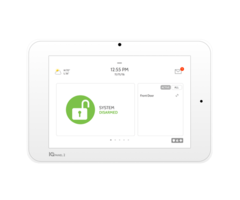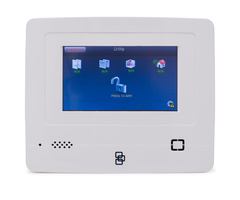What Does a Home Security System Do?
There are many things that a home security system does. But there are two main functions that most people consider when they think about an alarm setup. The first is sending out alerts to inform the end user or a central station about an alarm. The second is performing smart home functions.
A home security system consists primarily of a central control panel and various security sensors. Often, the terms "system" and "panel" are used interchangeably, since the panel truly is the "brains" of the entire setup. The panel is designed to receive signals from the sensors. There are many sensors that are used with home security systems. Some popular examples include door and window contacts, motion sensors and glass break sensors.
When a sensor is activated, it sends an alert to the control panel. This lets the system know that there is something that requires attention or acknowledgment. It could be something as simple as a door being opened or the system being disarmed with a key fob input. But it could also be something serious, like an intruder breaking a window or a smoke detector being set off. The system will then respond accordingly based on the programming settings for that sensor. Again, the response could range from simply displaying the faulted sensor to triggering an immediate system alarm.
The benefit of an alarm system is that it can send outbound alerts. These alerts are almost always programmed so that they are sent to an end user or a central monitoring station. When a central monitoring station receives a notification about an alarm, they can send emergency dispatch to the end user's residence to help control the situation. A user can also forgo service with a monitoring station and instead receive their own alerts about alarms. A user will receive these alerts through text and/or email in most cases. From there, it is up the end user to contact the authorities.
But to send out any alerts, an alarm system must have some type of communication path set up. In most cases, a modern alarm system will use WIFI and/or cellular service to communicate. The system will also need to be active with an alarm company to facilitate this service. This service is known as "monitoring", and it is crucial to any robust home security setup. While it is possible to use a home security system without monitoring, the system will then have no way of sending outbound signals to a monitoring station or to an end user. In that case, the system can still produce sounds to alert on-site users. But anyone off-site will have no way of being immediately alerted to an alarm.
The other main function of an alarm system is to perform smart home functions. This is also referred to as Z-Wave home automation. This feature is somewhat optional, and it is usually seen as secondary to monitoring service. But alarm systems often serve as excellent Z-Wave hubs which makes them ideal for these applications. However, please note that the system will need to have a Z-Wave controller in order to achieve any smart home functionality. Some systems come with a Z-Wave controller built-in, while others need to have one added separately.
Once a panel has been set up for Z-Wave, it can be used to control Z-Wave smart home devices. Popular Z-Wave devices include lights, door locks and thermostats. Users can also set up their Z-Wave devices so that they activate automatically based on a schedule or with certain system events. This is made possible using rules and scenes, and it is one of the most useful aspects of Z-Wave devices.
Most alarm systems can also connect with an interactive service platform. This type of service allows a user to access their alarm system remotely using a mobile app on their smart phone. Once a user has accessed the service and logged-in to their account, they can control their system in a number of different ways. This includes arming and disarming their system, controlling Z-Wave smart home devices, viewing the current status of security sensors and more. Thanks to interactive services, a user can operate their system from across the room or across the globe. Some popular interactive services for alarm systems include Honeywell's Total Connect 2.0 and the Alarm.com service.
Did you find this answer useful?
We offer alarm monitoring as low as $10 / month
Click Here to Learn MoreRelated Products





Related Categories
- Home Security Systems
- Business Security Systems
- Apartment Security Systems
- DIY Wireless Security Systems
- Monitored Home Security Systems
- Small Business Security Systems
- DIY Wired Security Systems
- Answered
